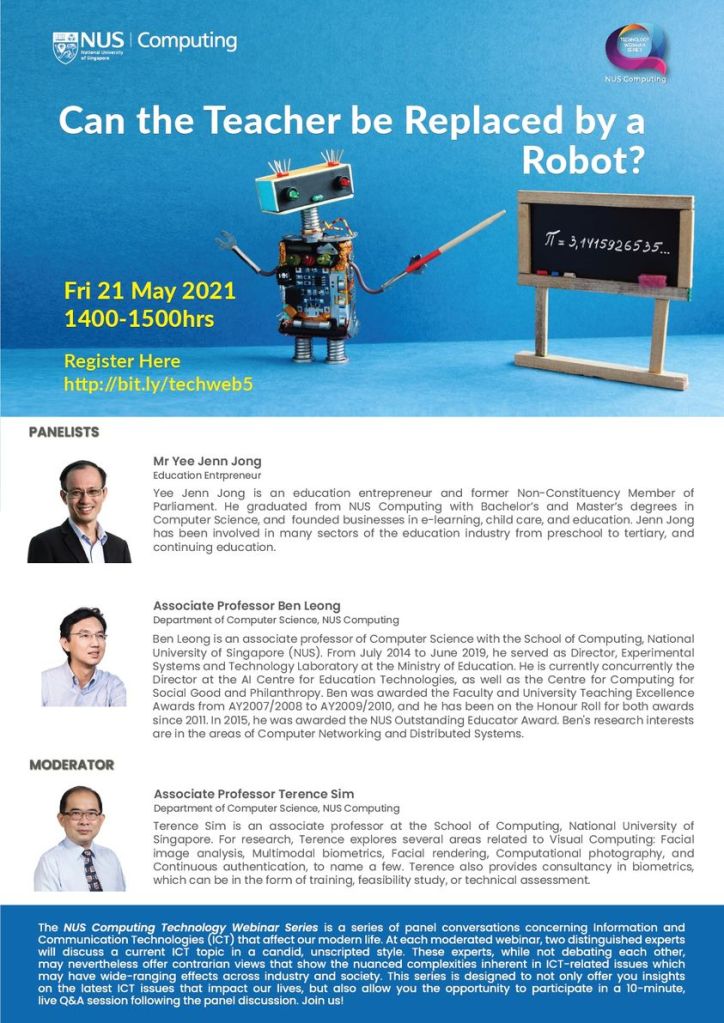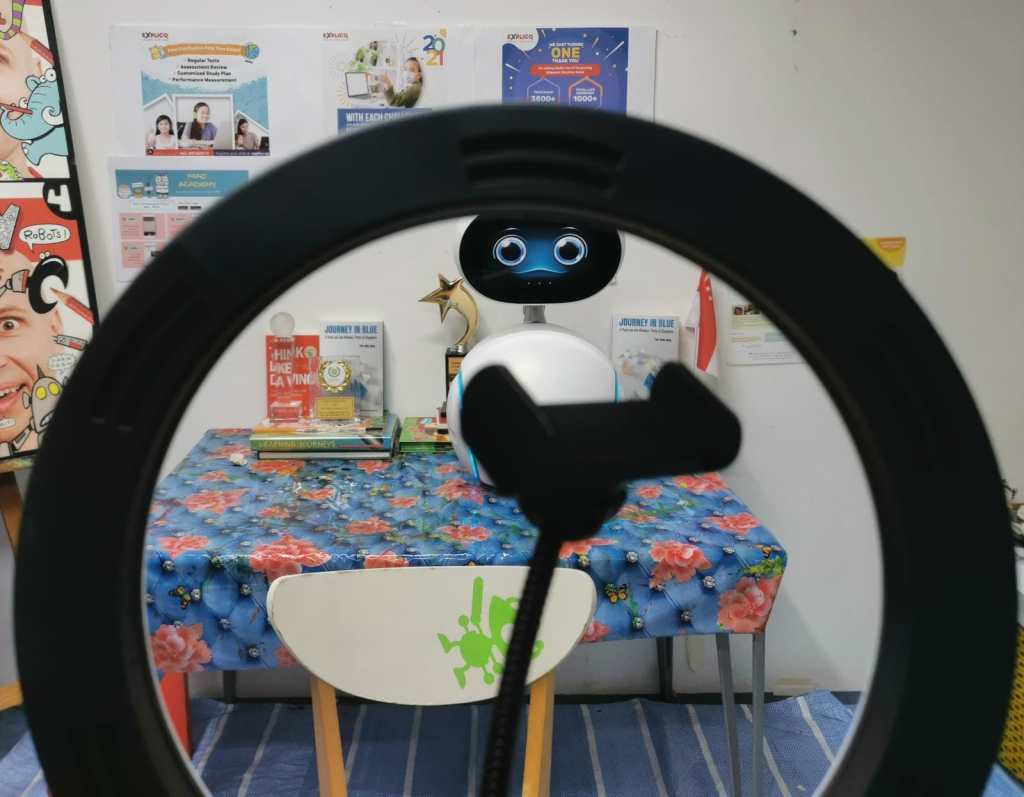I took part in a web talk show organised by NUS School of Computing on 21 May 2021. The following were 4 questions posted to me earlier by the moderator of the talk show, Prof Terence Sim.

- Education Technologies have rapidly improved in recent years. Examples include: online courses and virtual reality skills training. What do you think future Ed-Tech will look like?
EdTech had indeed gone quite far since the pioneer days on the late 1990s and 2000s when I was involved in first providing computer-based education for children, then as GM for the Kinderworld group of companies and then as founder of ASKnLearn (now Wizlearn). I have pioneer in the early days of floppy disk and CD-ROM to the first-generation Learning Management System (LMS).
Today, internet is pervasive and low cost, accessible on mobile devices anyway. It is available to many people at affordable cost. We have giant unicorn EdTech companies in China and India even ahead of those in the western world. EdTech is driven very much by the companies that can successfully raise fund and eventually have a viable business model, of course supported with ongoing R&D and open-source from academic and research institutions as well. There are always cool technologies being created but how Ed-Tech may be driven in future also depends on the viability of the research.
Technologies that have driven recent Ed-Tech include AI that analyses students learning for personalised learning, Bots to answer questions, immersive and augmented reality, Internet of Things and so on. In the end, how fast something can move and sustain depends on how commercialisable they can be. I was involved in the early days of augmented reality with schools and automated marking of essays. They were too costly then fifteen years ago. Content creation and training of the automated marking system were too expensive and long. Those companies that invested in these then could not survive ccommercially.
I see short and mid-term successful EdTech to involve:
- Easily accessible via mobile learning, byte-sized, just-in-time learning. Also learning that can deliver results in exams, whether for students or for adult learning tied to certifications.
- Content may be king, but if content can be easily created by users, then content owners may not always be king. Sharing platforms with mass user base that can deliver byte-sized learning content in intelligent way customised to learners’ preferences, even just for fun learning will do better than traditional content owners charging subscription.
- Linked with devices through IoT, now better supported with 5G
- Data-driven insights for personalised learning
- Automated tools to support learning institutions (i.e smarter LMSes) and classroom interactions.
Declarations: I have some vested interests in three EdTechs
- KooBits – Leader in Singapore Pri math content and moving now into Science as well. Huge bank of content and animated clips, gamify platform, some AI to provide customised learning content based on how students answer questions.
- Miao Academy – Has a Miao Messenger Academic Bot that helps students with Math query including theories and definitions, and homework, and a Miao Math App that uses photo snapped by users to search for similar questions with solutions and learning points for any Math homework problem.
- Explico.sg – Online diagnostic assessment for upp pri and lower sec, byte-sized modular learning based on weaknesses / what users want to learn. Trying to redefine the tuition market but providing learning for those concepts that students really need and at their convenient time remotely.
In the longer term, we could see on a comercialisable way:
- Robots (I will talk more later. Right now too expensive and not smart enough)
- Immersive learning. Right now, tools to support are expensive, not readily available and still costly to create content. But moving towards being ubiquitous now with mobile devices able to support immersive learning and content creation cost dropping.
- Integrated learning with real devices (think driving lessons. Can a smart car train a learner? Real feedback from operating the device)
- Autograding of essays and speech.
Will an AI Robot be able to replace the human teacher? What part of pedagogy can or cannot be replaced? More importantly, what should not be replaced?
My son, who just finished first year in a local university, first reaction to this question was, of course can. He already relies on online videos to learn what he cannot understand from school and there’s plenty of such free content.
That’s a simplistic answer. He’s in varsity and they are expected to be able to learn independently, whether the teacher teaches well or not.
What is the AI Robot? If we look at it strictly as a humanoid, then we are quite far from it doing anything intelligent and to be affordable enough to be common. Just google search for robots in classroom and you will find examples in Finland, India, China, etc. I bought Zenbo from Taiwan when I went there in Dec 2018, before Covid. I brought two back. I saw it being programmed by students and lecturers in the early childhood department of the National Pingtung University of Science & Technology and being used in kindergartens. Simple coding using Scratch-like interface – drag and drop. Zenbo cost just over S$1,000 so I bought to just try. Good for arousing interest in children and having fun but far from replacing the teacher. Too much coding to do. There’s simple voice interaction with Hey Zenbo, Hey Siri and Hey Google but you cannot do a meaningful conversation with it.

There are different aspects in the classroom, also depending on age:
- Teaching – This part, the robot still can be pre-coded or deliver standardized content. Mainly to deliver content but once you get to Q & A or observing learning, the AI still some way to go. I suppose one day it can be intelligent enough to even help facilitate project discussion in a controlled context. Right now, not good enough.
- Care – For younger students, you need to have discipline and care in the classroom. Robots are not flexible nor smart enough. The best robots now to do home care and house chores are still quite basic, and very expensive. It will be a long time before it can be useful for looking after children in the classroom. (P2 Kid cried when Zenbo went into class!)
- Counselling – That’s even worse. Robots will find it hard to be an inspirational and motivating role model for students, or to provide counselling when students have problems. I have a daughter in social work. I have seen the difficult classrooms as well. There’s value is a caring and motivating teacher.
- Which age group will benefit most from adopting Ed-Tech: children, tertiary students, working adults, elderly? And which will benefit the least?
Ed-Tech is for all ages, but how we deploy will differ. I will look at question from two points – (1) Benefit as in how to learn better (2) Benefit as in how to make it even commercially viable in each market segment.
The tertiary and working adults, they are more independent in the way they learn – they will learn if they want to so we can skip investing on the frills – just deliver the content needed for their course requirement. For younger children, you will need some interactivity and fun to keep them on the system or with the robot. Interactivity and gamification cost money. You can help them learn better by using AI to zoom in on their needs using big data.
For commercial viability, companies still need to see how they can amass the competitive advantage at the most cost-effective way. Some will try to own content and earn by subscription; some will try to have massive no. of users and user generated content and earn by money from sponsors.
Each market will be viable for Ed-Tech. With Covid and more learning from home or anyway, there are new opportunities. The easiest to adopt will actually be for learners who need to get some professional certification. They will pay for the learning and assessment cos they need it for work or in Singapore case, get paid by Skills Future or WSQ money. For the global market, the massively online portals are definitely viable, once you get a critical mass. Some will pay for the certification.
For K12 space, it is hard to target the mainstream schools due to MOE policies. Everyone will want to try to disrupt the tuition market but it is not so easy. Content also differ across countries so if one is good with Singapore schools, it is not automatically scalable overseas.
- Do you think there should be policies in place to guide, even regulate, Ed-Tech? What policies are needed? Should these be made by MOE, or be left to individual schools?
From the perspective of a commercial player in this field, the less regulation and control, the better. For the B2C space, there’s also no need to regulate. It is up to the market. Of course, there might be parents worry about screen time but I am not sure if regulation is a good thing to use for controlling this.
Where MOE is concerned, they are the market maker. I was involved from the first ICT Masterplan in the late 1990s. There was mass buying of CD-ROMs and computers with mostly HQ controlled budget – every school get standardised software and systems. MOE tried their own LMS in the early 2000s but it was quickly killed by the dotcom revolution because the platforms that came out were far better in technology and better used by the schools than the School DMR by MOE. So they killed the project in 2002. Then we were hit by SARS and most schools could not do e-learning. Then MOE released money to the schools to decide on the e-learning platforms they wish to adopt from the industry. The industry flourished and there were learning tools customised for schools as companies fight for market share. The problem was that some companies closed and caused problems for schools and MOE found it hard to control. Then they killed the market with SLS, which is own and managed by MOE. Now the local EdTechs are not interested in the local school market and innovations have switched to B2C.
Whether it is good or not is subjective. There will be fewer innovations for the schools cos it is much harder to move ideas when it is top down.
Policies can dictate EdTech from the way it influences the market through the government budget especially for schools and for adult learning market using skills future and WSQ. I don’t see any value though in using policy to influence the B2C market or to direct innovation. It is best left to the market.
